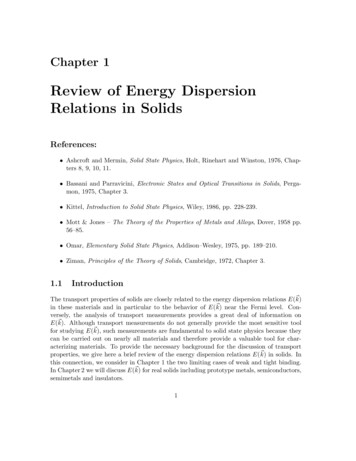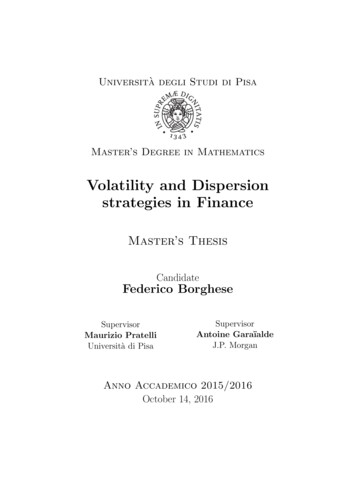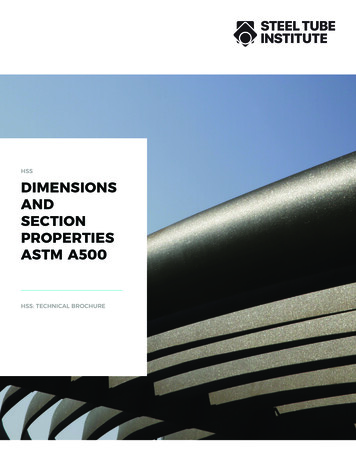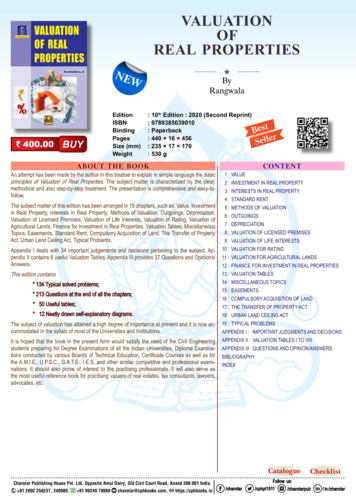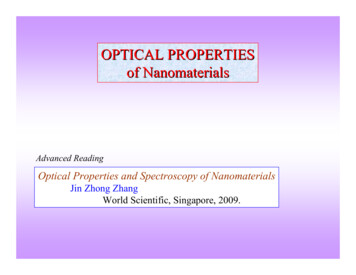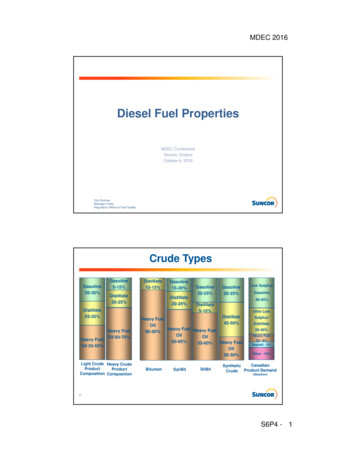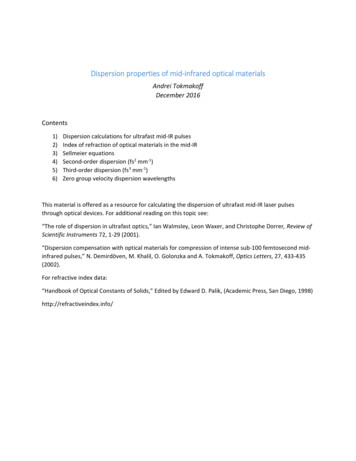
Transcription
Dispersion properties of mid‐infrared optical materialsAndrei TokmakoffDecember 2016Contents1)2)3)4)5)6)Dispersion calculations for ultrafast mid‐IR pulsesIndex of refraction of optical materials in the mid‐IRSellmeier equationsSecond‐order dispersion (fs2 mm‐1)Third‐order dispersion (fs3 mm‐1)Zero group velocity dispersion wavelengthsThis material is offered as a resource for calculating the dispersion of ultrafast mid‐IR laser pulsesthrough optical devices. For additional reading on this topic see:“The role of dispersion in ultrafast optics,” Ian Walmsley, Leon Waxer, and Christophe Dorrer, Review ofScientific Instruments 72, 1‐29 (2001).“Dispersion compensation with optical materials for compression of intense sub‐100 femtosecond mid‐infrared pulses,” N. Demirdöven, M. Khalil, O. Golonzka and A. Tokmakoff, Optics Letters, 27, 433‐435(2002).For refractive index data:“Handbook of Optical Constants of Solids,” Edited by Edward D. Palik, (Academic Press, San Diego, 1998)http://refractiveindex.info/
Dispersion calculations for short mid‐IR pulsesThe optical dispersion experienced by a short pulse propagating through an spectrometer iscalculated in the frequency domain from the spectral phase ϕ(ω). The field is expressed asE I ( )ei The spectral phase is related to the frequency dependent optical pathlength P as P cand the optical pathlength is related to the index of refraction and geometric path length asP ( ) n( ) ( ) . Commonly, we choose to expand ϕ about the center frequency of the pulsespectrum ω0:12 0 1 0 2 0 2 1 1 P P 0 c 0 2 2 2 01 P 2 P 2 c 2 0Here, the first order term ϕ(1) is inversely proportional to the group delay for the pulse and thesecond order term ϕ(2) is the group delay dispersion or group velocity dispersion (GVD). If theGVD is non-zero, the pulse is said to be “chirped.” A positive chirp means that the lowfrequencies within the bandwidth have a smaller group delay than the higher frequencies, i.e. thatlower frequencies precede the higher frequencies.The optical phase expressed as frequency derivatives with respect to optical path lengthcan also be expressed in terms of wavelength derivatives 2 c 2 c 2 P P 2 P 2 c Andrei Tokmakoff 12/7/2016
2 2 P 2 P 2 2 c 2 2 2 P 2 P 2 2 c Then, the second and third order phase is given by (2) 2 2 3 2P2 c 2 2 2 (2) 3 32 c 2 3 3 P 2 2P 32 c 2 c 2 32 c 2 (3) 2 P 4 3 P3 4 2 c 3 3 2 Propagating through materialTo help in describing the dispersion that results from propagating through optical materialcharacterized by a frequency dependent index of refraction n(ω), it is helpful to calculate thespectral phase in terms of the phase acquired per mm of material traversed. The expansioncoefficients typically quotes in units of (fs)i mm-1 are1 i iwhich can be calculated from the wavelength derivatives for the index of refraction i (i ) i n( ) iFollowing the derivation above, we see that the second and third order dispersion are 3 2 22 c 2 4 3 2 3 3 3 2 4 cMost optical materials in the visible and near-IR spectrum have β2 0, meaning that passing atransform limited pulse through this material will result in positive chirp on the pulse. The figure i 2
below illustrates how a transform-limited pulse with a center wavelength of λ0 6 μm (1667cm-1) and a bandwidth of σ 0.6 μm (167 cm-1) is chirped after passing through 1 mm of CaF2.The left panel shows the spectral phase imparted by the CaF2. The right panel shows the pulseshape obtained by Fourier transformation before and after the material (neglecting the groupdelay, γ1).In the mid-infrared region ( 3-20 μm), the sign of most transparent materials changes frompositive no negative, meaning that there is a zero GVD wavelength with γ2 β2 0. Near thiswavelength a pulse can propagate through material dispersion free (to second order). Also, thismeans that a combination of two optical materials with opposite sign for β2 can be used tocompress a pulse or zero the GVD for an optical device.3
Index of Refraction for IR 46810122.8GaSeAgGaSe2 (o)ZnSeKRS5AgGaS2 810λWavelength (microns)1214
Second Order Dispersion for IR Materials (fs2/mm)GaSeZnSeZnSBaF2CaF2MgF2 (o)GaN1 1030 1 103 2 1032468GeSiCde (o)InAsGaAsZnSeInPSi3N42 1030 2 1032468101214GeKRS5KBrAgGaSe2 (o)NaClAgGaS2 (o)1 1030 1 103 2 103 3 103246810λWavelength (microns)1214
Third Order Dispersion for IR Materials (fs3/mm)GaNMgF2 (o)CaF2BaF2ZnSGaSeZnSe2 1041.5 1041 1045 10302468Si3N4InAsInPGaAsZnSeCde (o)GeSi2 1041.5 1041 1045 10302468101214AgGaS2 (o)NaClAgGaSe2 (o)KBrKRS5Ge2 1041.5 1041 1045 1030246810λWavelength (microns)1214
Zero Group Velocity Dispersion Wavelength12561 cm–19.94101006864.833.6042 1.341.551.5963097446 64601.9351952.2427794.0420705.2119205.525.681810 17625.991515167124734474IR MaterialSiGeAsInAsGaInAgPGaSe2 (o)CdSe(o)SeGaSeZnZnSAgGaS2 (o)N23BaF4iN2SGa2CaF(o)0MgFλ0 (μm)6.60
Dispersion properties of mid‐infrared optical materials Andrei Tokmakoff December 2016 Contents 1) Dispersion calculations for ultrafast mid‐IR pulses 2) Index of refraction of optical materials in the mid‐IR 3)


